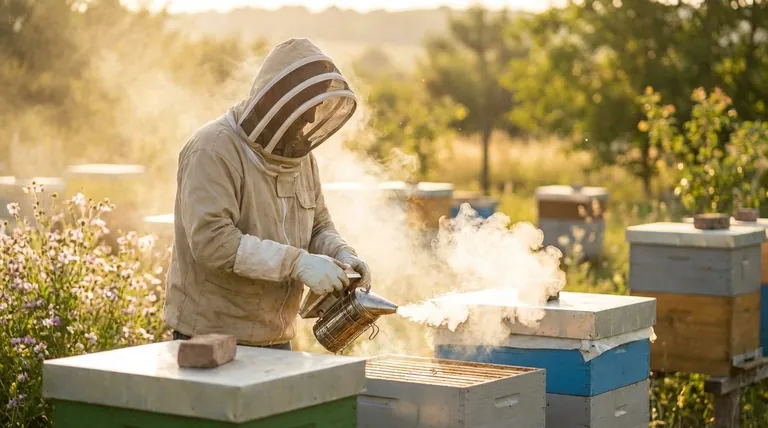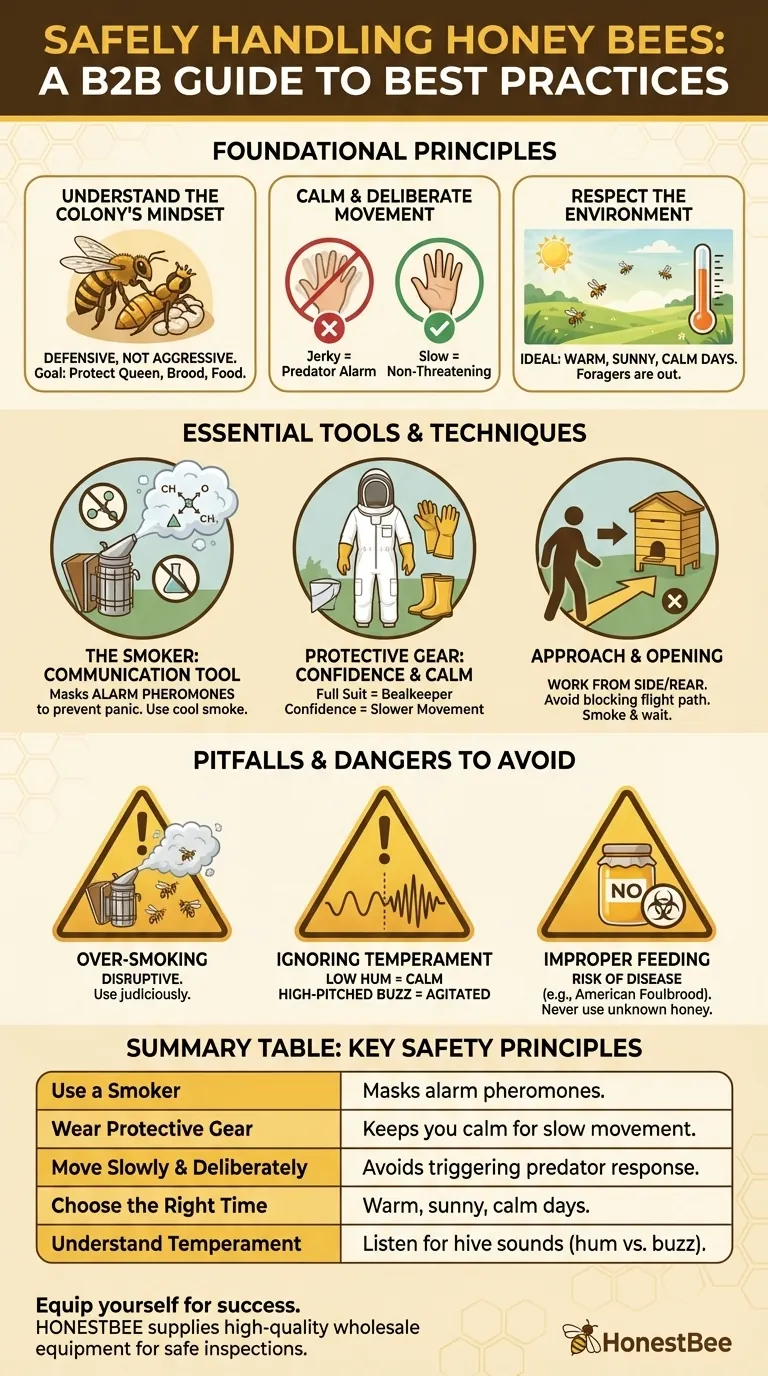To handle honey bees safely, you must prioritize preparation, calmness, and an understanding of the colony's defensive instincts. The core practices involve using a smoker to mask alarm signals, wearing appropriate protective gear to maintain your composure, and moving in a slow, deliberate manner that does not trigger a threat response from the bees.
Safe beekeeping is not about dominating the hive; it is about working in partnership with it. True safety comes from understanding and respecting the bees' natural behaviors, allowing you to anticipate their reactions and handle them with quiet confidence.

Foundational Principles of Bee Handling
To move beyond a simple list of rules, you must first understand the "why" behind them. A bee's world is governed by instinct, and your actions are interpreted through that lens.
Understand the Colony's Mindset
Honey bees are not inherently aggressive; they are profoundly defensive. Their primary goal is to protect their queen, brood (young bees), and food stores.
Every action they take when you are near the hive is a calculated response to a perceived threat. Seeing you as a non-threatening part of the landscape is the goal.
The Importance of Calm and Deliberate Movement
Sudden, jerky movements mimic the actions of a predator, like a bear tearing into a hive. This triggers an immediate defensive alarm.
Move slowly and purposefully around the hive. If you drop a tool, retrieve it smoothly. This calm energy communicates that you are not a threat, significantly reducing the bees' stress and defensiveness.
Respect the Hive's Environment
Choose the right time for inspections. The ideal conditions are a warm, sunny, and calm day, typically between mid-morning and mid-afternoon when many forager bees are out of the hive.
Avoid inspecting on cold, rainy, or windy days. The bees will be confined to the hive, more crowded, and generally more irritable.
Essential Tools and Techniques
Your tools are not just for your protection; they are for communicating with the colony in a language it understands.
The Smoker: Your Primary Communication Tool
The smoker is the most critical tool in beekeeping. Its function is often misunderstood as simply "calming" bees.
In reality, smoke masks the alarm pheromones that guard bees release when they perceive a threat. By disrupting this chemical signal, you prevent a panic from spreading throughout the colony, allowing you to work more easily.
Use cool, white smoke from a natural fuel source like cotton, burlap, or pine needles. A few gentle puffs at the hive entrance and under the lid is all that is needed to begin.
Protective Gear: Choosing Your Level of Confidence
Protective gear's primary function is to keep you calm. If you aren't worried about stings, you will move more slowly and deliberately, making the bees less defensive.
A beginner should always start with a full bee suit, gloves, and a veil. As you gain experience and learn to read your bees' temperament, you may choose to use less gear, but a veil is always recommended to protect your face and eyes.
Approaching and Opening the Hive
Never approach a hive from the front, as this blocks the bees' flight path. Always work from the side or the rear of the hive.
After applying a few puffs of smoke to the entrance, wait 30-60 seconds. Then, gently crack the outer and inner covers, puffing a small amount of smoke into the opening before removing the lid entirely.
Understanding the Pitfalls and Dangers
Effective beekeeping also means knowing what not to do. Certain common mistakes can endanger you and, more importantly, the health of your colony.
Over-smoking the Hive
While smoke is essential, too much of it can be counterproductive. Excessive smoke can drive bees off the frames you need to inspect and can be overly disruptive to the colony's work. Use it judiciously, not constantly.
Ignoring the Bees' Temperament
Every colony has its own personality, which can change based on the season, weather, or queen. Pay attention to the sound of the hive. A low, steady hum is calm. A high-pitched, loud buzz indicates agitation. If the bees are overly defensive on a given day, consider closing the hive and trying again later.
The Danger of Improper Feeding
Never feed your bees honey from an unknown source, such as a grocery store. This honey can contain spores of devastating diseases like American foulbrood, which can infect and destroy your colony.
If you must feed honey, only use it if it comes from your own known disease-free hives. When feeding, always place the feeder inside the hive to avoid attracting pests or inciting "robbing," where bees from other colonies attack your hive to steal its resources.
Making the Right Choice for Your Goal
Your approach to handling bees should align with your experience level and immediate objective.
- If your primary focus is learning as a beginner: Always use full protective gear. Your goal is to build confidence by remaining calm and moving slowly, regardless of the bees' reactions.
- If your primary focus is efficient hive inspection: Pay close attention to the weather and the sound of the hive. Use the smoker with precision to manage the colony's alarm response without disrupting it unnecessarily.
- If your primary focus is colony health and biosecurity: Be meticulous about your equipment and feeding practices. Never introduce outside honey and be vigilant about preventing robbing behavior.
Ultimately, safe and successful beekeeping is a partnership built on respect for the colony's complex world.
Summary Table:
| Key Safety Principle | Why It Matters |
|---|---|
| Use a Smoker | Masks alarm pheromones to prevent colony-wide panic. |
| Wear Protective Gear | Keeps you calm, allowing for slow, deliberate movements. |
| Move Slowly & Deliberately | Avoids triggering the bees' defensive predator response. |
| Choose the Right Time | Inspect on warm, sunny, calm days when foragers are out. |
| Understand Bee Temperament | A high-pitched buzz signals agitation; a low hum is calm. |
Ready to handle your bees with confidence and care? Equip yourself with the right tools and knowledge. HONESTBEE supplies commercial apiaries and beekeeping equipment distributors with high-quality, durable beekeeping supplies and protective gear through our wholesale-focused operations. Let us help you ensure every hive inspection is safe and successful.
Contact HONESTBEE today to discuss your beekeeping supply needs!
Visual Guide

Related Products
- Square Folding Bee Hat Veil with String for Beekeeping
- Heavy Duty Cowboy Beekeeper Hat with Visibility Veil Outdoor Professional Beekeeping Protective Gear
- Beekeeper Cowboy Hat and Veil for Beekeeping
- Yellow Plastic Bucket Pail Perch for Beekeeping
- Long Langstroth Style Horizontal Top Bar Hive for Wholesale
People Also Ask
- How should the beekeeping hat veil be cleaned? The Only Safe Method to Preserve Protection
- What are the different types of protective veils for beekeeping? Choose the Right Protection for Your Apiary
- What features enhance the quality of the beekeeping veil? Choose the Right Protection for Your Apiary
- Why is protecting the head important in beekeeping? Essential Safety for Every Beekeeper
- What is the purpose of a hat and veil in beekeeping? Essential Protection for Head & Face



















